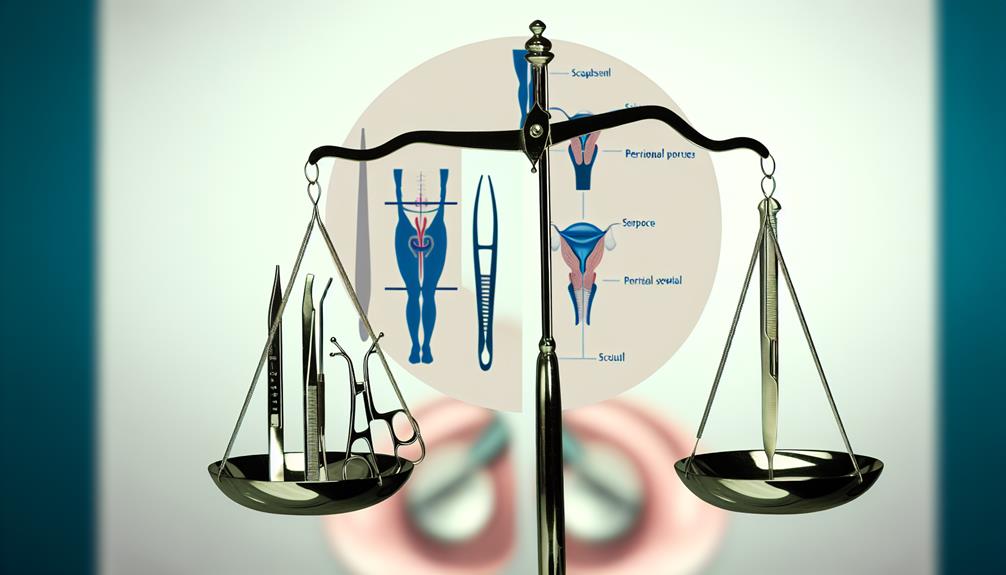The Pros and Cons of Peritoneal and Penile Inversion Methods in Vaginoplasty


Table of Contents
ToggleWhen you’re considering vaginoplasty, it’s vital to weigh the pros and cons of the Peritoneal Pull-Through (PPT) and Penile Inversion Vaginoplasty (PIV) methods. The PPT method offers greater depth and natural lubrication, which can make life post-surgery easier, but there’s not a lot of long-term data on it yet. On the other hand, PIV is a tried and true method that many surgeons are familiar with, and it typically has a shorter recovery time. However, it might cause issues with lubrication and could require more procedures down the road. So, which method suits you better? Let’s investigate further.
When pondering vaginoplasty, it’s vital to understand the primary techniques: Penile Inversion Vaginoplasty (PIV) and Peritoneal Vaginoplasty (PPV), each with its own set of benefits and drawbacks. For transgender women, choosing the right method can greatly impact the surgery’s success and their general satisfaction.
Penile Inversion Vaginoplasty (PIV) is the most commonly performed technique. It uses the skin from the penile shaft and scrotum to create the vaginal canal. This method is widely regarded for its reliable outcomes and established safety profile. However, PIV often requires regular cleaning and douching to maintain the neovagina.
On the other hand, Peritoneal Vaginoplasty (PPV) uses the peritoneal lining from the abdomen. This approach can provide a more natural, self-lubricating vaginal lining, which may improve sexual experiences. PPV generally involves a longer surgical duration and recovery time but offers reduced risks of scarring and stenosis.
Understanding the surgical techniques used in both PIV and PPV helps you make an informed choice. Each method has unique pros and cons, so it’s imperative to reflect on your anatomy, goals, and the expertise of your surgeon when deciding which technique is best for you.
Let’s start by exploring the Penile Inversion Vaginoplasty (PIV), the gold standard technique for creating a neovagina using penile and scrotal skin.
In this vaginoplasty method, your surgeon uses the penile skin inversion technique to fashion the vaginal canal. This method is highly regarded for its ability to produce a functional and aesthetically pleasing neovagina.
During the procedure, your surgeon performs several key steps: an orchiectomy (removal of the testicles), partial penectomy (removal of part of the penis), and then uses the remaining penile and scrotal skin to create the vaginal lining. This is often combined with labiaplasty and clitoroplasty to form the external genitalia. The surgery usually lasts between 2-4 hours.
One of the main tasks post-surgery is to use vaginal dilators for about six months to prevent neovaginal stenosis, a narrowing of the vaginal canal.
While PIV is generally safe, it does come with potential complications, such as changes in the urine stream, tissue necrosis, and rare rectal injuries.
Despite these risks, the penile inversion technique remains a popular choice for male to female vaginoplasty due to its reliable results.

The Peritoneal Pull-Through Method (PPT Vaginoplasty) offers a unique approach by using the abdominal lining to create a neovagina, providing increased depth and elasticity. This technique uses the peritoneum, a natural tissue from the abdomen, which can offer benefits over traditional penile and scrotal skin methods. Typically, the PPT method is less invasive, requiring only five small incisions, and it can add an extra 2-3 cm of vaginal depth.
One of the standout advantages of peritoneal pullthrough vaginoplasty is the natural lubrication provided by the peritoneal lining. This reduces the need for regular cleaning and lubrication compared to other vaginoplasty techniques. It’s particularly beneficial for patients with limited donor skin options or those seeking revision surgeries.
However, lifelong dilation is necessary to maintain the vaginal depth achieved through this method. While the risk of scarring is lower than with skin grafts, potential complications from abdominal surgery still exist.
Long-term outcome data for transgender and nonbinary patients is limited, but the PPT method shows promise. In general, it’s a compelling option for those seeking improved depth and elasticity in their neovagina.
Both the Peritoneal Pull-Through (PPT) and Penile Inversion methods in vaginoplasty offer distinct benefits and drawbacks that can influence your surgical decision.
With the peritoneal technique, you get increased vaginal depth and elasticity since the neovagina is created from the peritoneal lining. This method reduces the risk of scarring and requires less pre-operative hair removal. Another perk? The peritoneal neovagina is self-lubricating, which can be a significant advantage in daily life and sexual activity.
On the other hand, penile inversion is a more established and familiar method for many surgeons. This technique typically involves a shorter recovery time, meaning you might get back to your routine quicker. However, penile inversion can lead to issues with lubrication and requires regular cleaning and douching to maintain hygiene. There’s also a higher risk of neovaginal stenosis, which might necessitate supplementary procedures.
Choosing between these methods depends on your anatomy, goals, and available surgeon expertise. The peritoneal method may offer a more natural tissue integration, while penile inversion boasts a longer track record and more documented patient outcomes. Each method has its strengths and challenges in the process of gender affirmation.

Your postoperative care for both Peritoneal and Penile Inversion Vaginoplasty is fundamental for maintaining vaginal depth and preventing complications like stenosis.
Right after surgery, you’ll need to use dilators regularly. This helps keep your neovagina open and prevents it from narrowing. Typically, you’ll need to dilate for about six months, but this can vary based on your surgeon’s advice.
For those who undergo Peritoneal Vaginoplasty, there might be a bit less dilation needed since the peritoneal lining can be self-lubricating. However, don’t skip this significant step; it’s crucial for your recovery.
On the other hand, Penile Inversion might involve a shorter recovery time, but you still need to be diligent with your postoperative care to avoid complications.
Both methods come with risks like vaginal scarring and changes in urinary function. So, keeping up with your follow-up appointments is key.
You’ll usually stay in the hospital for about two nights with Peritoneal Vaginoplasty, while Penile Inversion might require less time.
Adhering to these postoperative protocols guarantees your neovagina heals well and functions effectively, helping you achieve the best possible outcome.
Yes, penile inversion is generally safe. It’s a well-established technique with a lower complication rate compared to more invasive methods.
Risks like vaginal narrowing and urethral infections exist, but serious issues are rare. However, factors like smoking and obesity can increase risks.
Ensuring you follow post-op care instructions and having a support system will help in achieving the best outcomes. Always consult with your surgeon for personalized advice.
Choosing between the Peritoneal Pull-Through (PPT) and Penile Inversion Vaginoplasty (PIV) is like picking between two paths in a forest.
PPT offers lush, vibrant surroundings (better depth and lubrication) but lacks a well-trodden trail (limited long-term data).
PIV is a well-worn path (established method) but might be rocky (issues with lubrication and stenosis).
Your expedition should consider your unique landscape and your surgeon’s expertise to find the best route.
 Featured PostsNovember 5, 2025Changing Bodies, Changing Desires: Sex Identity in Transition
Featured PostsNovember 5, 2025Changing Bodies, Changing Desires: Sex Identity in Transition Featured PostsNovember 4, 2025Passing Tips Every Trans Girl Should Know
Featured PostsNovember 4, 2025Passing Tips Every Trans Girl Should Know Featured PostsNovember 4, 2025Trans 101: The Facts Everyone Should Know
Featured PostsNovember 4, 2025Trans 101: The Facts Everyone Should Know Featured PostsNovember 4, 2025Beyond the Basics: An In-Depth Preparation Roadmap for Your Facial Feminization Surgery Consultation
Featured PostsNovember 4, 2025Beyond the Basics: An In-Depth Preparation Roadmap for Your Facial Feminization Surgery Consultation